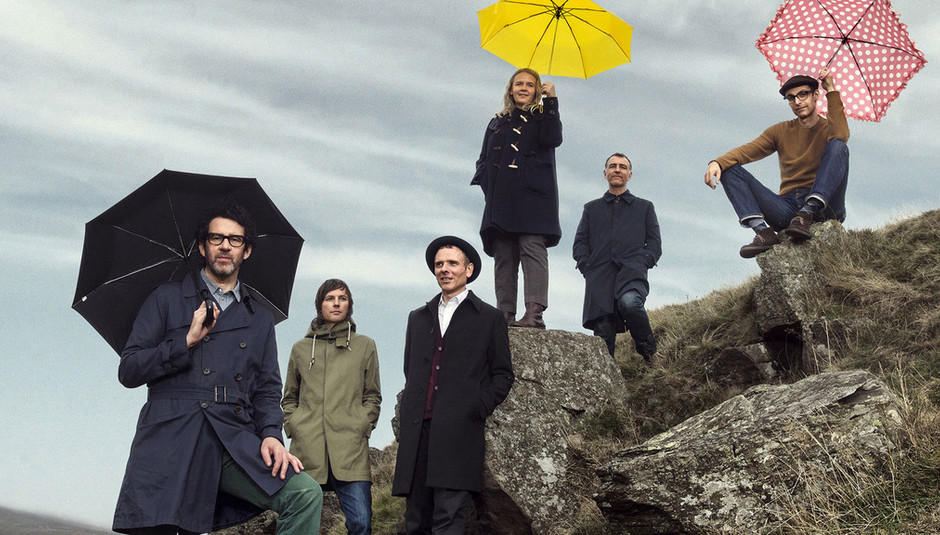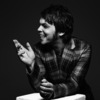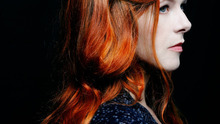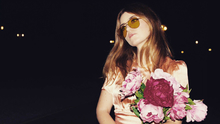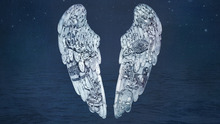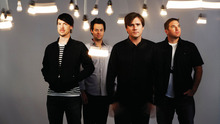Belle & Sebastian have been enchanting those of us of an indiepop bent for coming on twenty years now. Like all classic bands they’ve become far more than a group of people playing pop songs: Belle & Sebastian spin a web that ties together a ton of strands across art, film, literature and music to create an interconnected world of storytelling. The groups’ home city of Glasgow is as much a member of the bands as any of the actual humans involved, to the point that even their twitter handle is the not-that-obvious “@BellesGlasgow.”
On the one hand, they have survived by maintaining a consistent - though evolving - aesthetic, mostly courtesy of frontman Stuart Murdoch’s artistic eye, while on the other creating a body of work that is far more diverse than they’re usually given credit for. This week sees the release of Girls In Peacetime Want To Dance, their ninth album, letting the focus fall on the sharp, electropop end of their output, while maintaining the bittersweet storytelling that’s been their trademark ever since Melody Maker dubbed them “the new Smiths” back in the 90s.
As part of our Belle & Sebastian take-over week, DiS’ Marc Burrows met up with Stevie Jackson and Sarah Martin, multi-instrumentalist mainstays since the very early days of the band, to talk pop, disco, world-building and Glaswegian geography.
DiS: First of all I really love the album... I think the best since Dear Catastrophe Waitress, and I don't say that lightly, I like the two since…
Stevie Jackson: Usually doing interviews and all that kind of stuff, you read them and people are saying “It's the best thing we've ever done”, it's almost obligatory people say that, and I've only thought it two or three times really, like Tigermilk our first album when we had nothing to compare it to, and then that didn't happen again until... well I really like The Life Pursuit, or maybe it's that I just like things on it. I like all our records, but that one I had a feeling about, something different happening. I suppose Catastrophe Waitress had that feeling as well. I have that with this one. I can have that quiet confidence in the knowledge that we've done a really good one.
DiS: In the history of the band it feels like there's a little step up that happens every couple of years, like a power up on a computer game, where you sort-of move into a different place, or a different phase…
SJ: That's what I'm talking about. Every so often you get a jolt in the arm.
Sarah Martin: I think it's producers, in a way. It's when you work with a different person. I loved, loved making Write About Love, it was like we'd found our George Martin and I could just carry on making records this way and then a couple of the guys were more 'this is too comfortable, you've gotta keep moving”, and I was like, “ugh, do we really have to?”
I thought Dear Catastrophe Waitress was us doing something we'd not done. We'd never really worked with a producer before, and then working with [The Life Pursuit and Write About Love producer] Tony Hoffer was different again, and then this time... I think you get the kind of little power up from doing something with another collaborator.
DiS: Does the process of making an album change that much with different producers?
SJ: I think on this one it changed the most, in a sense. A brief history of the band: we made our first couple of records really quickly, just for budget. Tigermilk was five days, If You're Feeling Sinister was seven days, then after that there was a period where we were feeling our way, working with an engineer and producing our records in Glasgow ourselves, and sometimes it was going wrong, but it was definitely taking a long time. It felt to me at the time that it was a rudderless ship, we'd get there in the end, but it always seemed a bit chaotic.
That changed with Trevor Horn [Who produced Dear Catastrophe Waitress] it was the first time we'd had a gaffer. The producer we'd worked with previously, we'd come up at the same time as him so we couldn't quite seem him as a boss, if you know what I mean. Trevor was our first experience of '”he's in charge of the budget, we've got to deliver this on time, he's got to get it out of us.” That was really empowering at the time, just because it was really concentrated. It was also the first time we'd ever left Glasgow to make a record, aside from a bit of Storytelling in New York. We've done that ever since.
Trevor, his thing was making us sound good, he said “I like the songs but your records could sound better” so he kind of created a more lush, glowing ambience. Tony Hoffer, who did the next two, his thing -which was new to us at the time- was getting stuck into the actual structure of the songs, can we get to the chorus faster. That was a difficult thing, especially for our singer because he writes story songs. Every words important. But he said “do you want to make a pop record or a coffee table record?” we said a pop record, so he said “okay, well that verse has got to go.” That was a new thing, but essentially, as Sarah was saying, we'd have this process, we'd have thing thing called pre-production where we'd go to Glasgow and go through the tunes and basically knock them into shape to his satisfaction, then go to Los Angeles and record them. Bang-bang-bang, just getting them done.
Working with Ben Allen, on this one, that was a new thing again. He's from a hip hop background and you just felt it right away. It was a totally different way of working. He tended to construct things, he'd say “I like that bit” then he'd go off into his room upstairs and mess about with it and add things. He referred to it as “our” record, it was a total artistic collaboration as opposed to someone helping you, so I would have said that's been the change.
DiS: In reviews most people have latched onto the danceable elements, the lovely bubbling synths and the sharp electropop, which I don't think is that much of a strange departure because there's been disco and pop all through your history, if you go back as far as 'Legal Man' and stuff like that, there's disco in the DNA.
SM: And 'Electronic Renaissance' on the first album. It was there from the start really.
DiS: Did pushing that stuff to the fore come from the producers or was that your idea for this record?
SM: We had the songs before we even met them, the big pop tunes, 'Enter Sylvia Plath' and 'Play For Today', all those ones, they already had the rhythmic emphasis they still have. Actually in some cases I think Ben was thinking they were a little bit too genre-by-number, with 'Sylvia Plath' he wanted to de-Moroder it a little bit.
SJ: That's a good verb, isn't it? 'De-moroder'. I think the choice of working with Ben was because of the material we had.
SM: We knew what the songs were hinting at and we figured, well we should go with someone that can help us make interesting noises to go along with them. It's how he works- when things are that mechanical, grid-like, then he can just slot about the little building blocks, so that was good.
SJ: Have you ever seen guys working on a computer so fast? Total hip hop guys
DiS: When you first approach a record like this do you think 'we want to make this kind of album?' or does it grow organically in the writing?
SJ: Well, normally I'd say no, but Sarah reminded me that ages ago I'd said I really wanted to make a disco record. I play in a disco band back in Glasgow and I think I just said it as a laugh. It was definitely in the air. But see, I think it was there in the material. I think the rhythm was in the songs, we just wanted to upholster it. I heard Stuart describe rhythm as being a big inspiration to him of late, as another texture. It's not even a texture, it's a fundamental thing to work with. So he was coming into the rehearsal room and instead of starting with guitar and piano we were starting with bass and drums. It wasn't “here, we have the songs, let's do these in a disco style”, it was more integrated than that. Especially something like 'Nobody's Empire', which is the first song, that's not disco but it has four-on-the-floor bass drum.
DiS: When you've been a band for so long presumably you have to find new ways of creating?
SM: Actually when the band started, when it was Stuart teaching people songs he'd written on an acoustic guitar or the piano, I guess people hadn't necessarily found their place in things. You maybe didn't know what people are into, and i think eventually you start to draw from other people. You build it up from parts, rather from just strumming a guitar. It's kind of knowing people better than makes that viable.
SJ: Certain things change. Sarah was sitting with her iPad playing stuff off that just using Garageband. Even getting songs together was different. I felt different. I was even trying some of that myself, with not so much success, making wee keyboard noises, but then Chris our keyboard player had to learn them.
SM: I think that the rhythm thing you were talking about, Garageband on the iPad definitely helps because it's so easy to just tap away on the little hip hop drum kit thing, you can just slide things around and make pretty interesting things up.
SJ: It gives us that air of discovery again because you don't know what you're doing. It's almost being in a position where not knowing what you're doing is a creative thing.
SM: You're always generating interesting starting points, then you have to drag yourself away from it a lot of the time. There were a couple of times with songs I'd started on Garageband where Stuart would say “you're getting away from your original demo, I really loved that” and Ben would say “We're not working in Garageband, we're making a record here... step away. It's going to be at least as good as the demo you've made on a $2 app. At least as good.”
SJ: We're lucky in having a lot of people in the group, and going on for so long. It's harder when it's three or four guys, there's less of a pallet to play off of, you can see how they might get bored after three or four albums and force themselves into something else. For us the changes have always been quite natural. People contribute more as they go along, and the dynamic is always evolving.
SM: There's always slight tensions between people wanting to make music in a genre exercise, some folk like to stick to a thing like that, and others are like 'it doesn't matter', there's a healthy push and pull between people trying to adhere to principles, and other people thinking they don't matter. Somehow we find our own path down the middle.
SJ: There's no set way of how a band works, but for us it's a mixture of the people.
DiS: When I read the press release I was expecting this big disco electropop departure, but I don't think it's huge, huge, move for a Belle and Sebastian record…
SJ: 'Ever Had a Little Faith' could have been on our first album.
DiS: I love the way 'The Everlasting Muse' almost goes into 'Those Were The Days My Friends'
SJ: Actually Stuart came in and said I want it to sound like the Turkish 1974 Eurovision entry. I knew exactly what that means. I hadn't thought of 'Those Were The Days', but now you say it, I get it. It's certainly that strand of Eastern European pop and folk.
SM: Famously done by the Wedding Present on their Ukrainian LP.
SJ: It's a good tune. That's one of my favourites on the album, I think it's extraordinary.
SM: The words to that are really amazing.
DiS: Were any specific musical reference points here in terms of other records?
SJ: There's a couple of specific things. I wanted to make a disco album but I thought no-one would take me seriously. I think it was more capturing the sounds of records- great bass drums and things. For me some of the great records of the last 20 years have been hip hop records like Dr Dre- just the sound quality. We were certainly going for that. I don't remember ever specifically playing records as references, apart from Bob- he was playing a bit of Chic and Sister Sledge, to see how that works. I love 70s disco.
DiS: One of the things I've always wondered about Belle and Sebastian is where the songs come from in the band, how the song writing breaks down.
SJ: It kind of changed. It's become less clear as time went on. Sarah pointed out the change actually, the first three albums if you hear someone singing, Isobel [Campbell], or me or Stuart, then they wrote the songs, brought it in and everyone learned it. From the fourth album we started writing songs together a little bit. 'Don't Leave The Light On Baby' and 'Legal Man' were the first fruits of that. My memory is that by The Life Pursuit the lines could be quite blurred.
'Step Into My Office Baby' is a good example, which at the time was the first 50/50 song I'd written with Stuart. It was my tune, but we wrote the words together.As we went along we've used each other, in terms of being being influenced by each other and getting ideas from each other. It's good because when we do rehearse anybody can bring anything in, which is liberating for the people in the band who don't necessarily sing. Chris can come in with a chord sequence or an idea. Bob's written his first song on this album too, which is 'Party Line' which he nailed. I think it works because he had so much vision behind it. He started the demo the year before, he had the chorus and the riffs, he could hear it. Stuart wrote the words for the verse, but he had to do it two or three times, because it wasn't quite right- Bob was saying “make it more direct.” I'm not like that, I'm never that focussed, I like riding the wave. It wasn't left to chance, and the right producer was there for him. The planets aligned.
SM: But having seen Erasure the other night, they just keep on putting the hooks in. Hook-hook-hook. It's constant. I sometimes shy away from that, because I think some folk find it a bit boring, but I'm going to be unapologetic from now. 'Party Line' is that.
SJ: I wouldn't complain, I'm a pop guy. Bring on the hooks.
DiS: The other thing I love about Belle & Sebastian is that you feel like more than just a band, there’s a world that your fans buy into, from the lyrics to the artwork and videos. How considered it that?
SM: You'd have to ask Stuart about the artwork, but I totally agree. There's a sense of place and an identity that I don't think is considered. I think it's just the aesthetic we've coalesced around. I was saying earlier on that when I was 19 I went to New York on the hunt for Sonic Youth, but not necessarily for them as people, but their world. They're more than a band, it's not just record, they come from something else, and I think it's not out of the bounds of possibility to say it's the same for us. It's identifiable with a world, whether that's semi-fictional, semi-real. It's definitely Glasgow, but it exists in a connected world with other semi-fictional places. It's like an alternative universe. Our records do reach out beyond the records. Even being in the band, I walk around Glasgow and see something Stuart has referenced and go "ahhhh". Like the Botanic Gardens in Dunoon, which are in 'Another Sunny Day', also because we're friends and we go on outings together you get to see the little world we've curated for each other.
DiS: There's a sense that younger bands have this intense experience of reading the same books, watching the same films, that gets passed around between them and creates their world, it feels like despite being together so long that still exists in Belle and Sebastian?
SJ: I think, ironically, the initial period I felt it was the world in the songs people were attracted to, they used to gather and have picnics, but we weren't invited. Stuart actually went to one and felt uncomfortable because they didn't actually want him there.
SM: When Nick joined the band, he had a couple of friends who were leading lights in the Sinister mailing list, so Nick used to go quite a lot of Sinister picnics, and said it was a bit through-the-looking-glass. He stopped going when he joined the band.
SJ: A lot it is perception, there used to be a magazine called Select that really loved us, and we were always in it. They had big galleries of our fans and wrote about us all the time, and reading it I'd never felt so isolated from something I was actually in. I think the world was in the songs, but I never totally felt I was in that world, I felt slightly disenfranchised from it. I don't remember us ever sitting around calculating anything, I think a lot of it just came from Stuart's aesthetic with the covers and the stories and the characters. That was solid for the first couple of albums. Then other things happened, he said “I can't keep doing this, I need other influences” so other people started contributing. As times gone on I've felt more in tune with who the band are, and what the band is and how the band is perceived. Probably because I've been in the band for 18 years so that's who I am now. I don't even think about it any more. A lot of the magic is in the every day. We're just in Glasgow doing our own thing and that's the way it's always been. It reminded me of it, seeing Stuart's film (God Help The Girl), if If You're Feeling Sinister was Sgt Pepper, the films' Magical Mystery Tour. It really reminded me of that. Stuart was actually quite surprised when I said it reminded me of the early days of the band. I saw so many parallels, just the feeling of it. The mythologising. It made me realise what I'd always known anyway, how much of it is about the city, how much the city is a character in the songs.
SM: The city is a member of the band pretty much.
SJ: It made me feel good. And I liked the film, because I recognised the places, even though it is a fictional version.
SM: My friend Nick came to the Glasgow premier and he's an architect so obviously is very spatially orientated, and his main criticism is that “they went east-to-west up the Canal and it was wrong! Everybody knows the chippy is way out west!”
SJ: I never noticed that! Geographically it made sense to me. I could knit-pick a couple of things- they walk up Gardner Street and I didn't quite get that.
SM: I think it's Great George Street.
SJ: Ah. That makes sense.
Girls In Peacetime Want To Dance is released on January 19th via Matador Records.
Browse the rest of our special Belle and Sebastian week, here.

